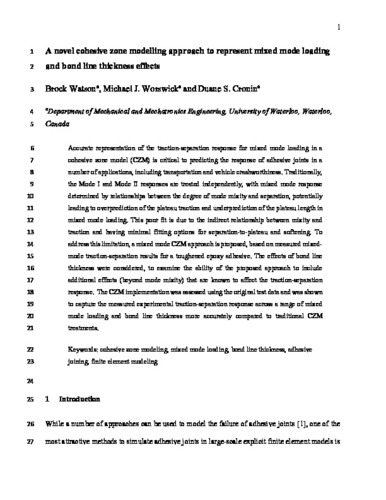| dc.contributor.author | Watson, Brock | |
| dc.contributor.author | Worswick, Michael | |
| dc.contributor.author | Cronin, Duane S. | |
| dc.date.accessioned | 2024-03-07 14:09:41 (GMT) | |
| dc.date.available | 2024-03-07 14:09:41 (GMT) | |
| dc.date.issued | 2023-02-28 | |
| dc.identifier.uri | https://doi.org/10.1080/00218464.2023.2184688 | |
| dc.identifier.uri | http://hdl.handle.net/10012/20383 | |
| dc.description | The CZM developed in this study will be made available to the research community as a shared library that can be linked into the LS‐DYNA finite element code. Please contact the corresponding author for information on accessing the CZM shared library. The authors report there are no competing interests to declare.
This is an Accepted Manuscript of an article published by Taylor & Francis in The Journal of Adhesion on [date of publication], available online: https://doi.org/10.1080/00218464.2023.2184688 | en |
| dc.description.abstract | Accurate representation of the traction-separation response for mixed mode loading in a cohesive zone model (CZM) is critical to predicting the response of adhesive joints in a number of applications, including transportation and vehicle crashworthiness. Traditionally, the Mode I and Mode II responses are treated independently, with mixed mode response determined by relationships between the degree of mode mixity and separation, potentially leading to overprediction of the plateau traction and underprediction of the plateau length in mixed mode loading. This poor fit is due to the indirect relationship between mixity and traction and having minimal fitting options for separation-to-plateau and softening. To address this limitation, a mixed mode CZM approach is proposed, based on measured mixed mode traction-separation results for a toughened epoxy adhesive. The effects of bond line thickness were considered, to examine the ability of the proposed approach to include additional effects (beyond mode mixity) that are known to affect the traction-separation response. The CZM implementation was assessed using the original test data and was shown to capture the measured experimental traction-separation response across a range of mixed mode loading and bond line thickness more accurately compared to traditional CZM treatments. | en |
| dc.description.sponsorship | Honda Development & Manufacturing of America || 3M Canada Company || ArcelorMittal || Ontario Centers of Excellence || Ontario Advanced Manufacturing Consortium || Compute Canada || Natural Sciences and Engineering Research Council of Canada | en |
| dc.language.iso | en | en |
| dc.publisher | Taylor and Francis | en |
| dc.relation.ispartofseries | The Journal of Adhesion; | |
| dc.relation.ispartofseries | ;99(16) | |
| dc.subject | cohesive zone modeling | en |
| dc.subject | mixed mode loading | en |
| dc.subject | bond line thickness | en |
| dc.subject | adhesive joining | en |
| dc.subject | finite element modeling | en |
| dc.title | A novel cohesive zone modelling approach to represent mixed mode loading and bond line thickness effects | en |
| dc.type | Article | en |
| dcterms.bibliographicCitation | Watson, B., Worswick, M. J., & Cronin, D. S. (2023). A novel cohesive zone modelling approach to represent mixed mode loading and bond line thickness effects. The Journal of Adhesion, 99(16), 2361–2380. https://doi.org/10.1080/00218464.2023.2184688 | en |
| uws.contributor.affiliation1 | Faculty of Engineering | en |
| uws.contributor.affiliation2 | Mechanical and Mechatronics Engineering | en |
| uws.typeOfResource | Text | en |
| uws.peerReviewStatus | Reviewed | en |
| uws.scholarLevel | Faculty | en |

